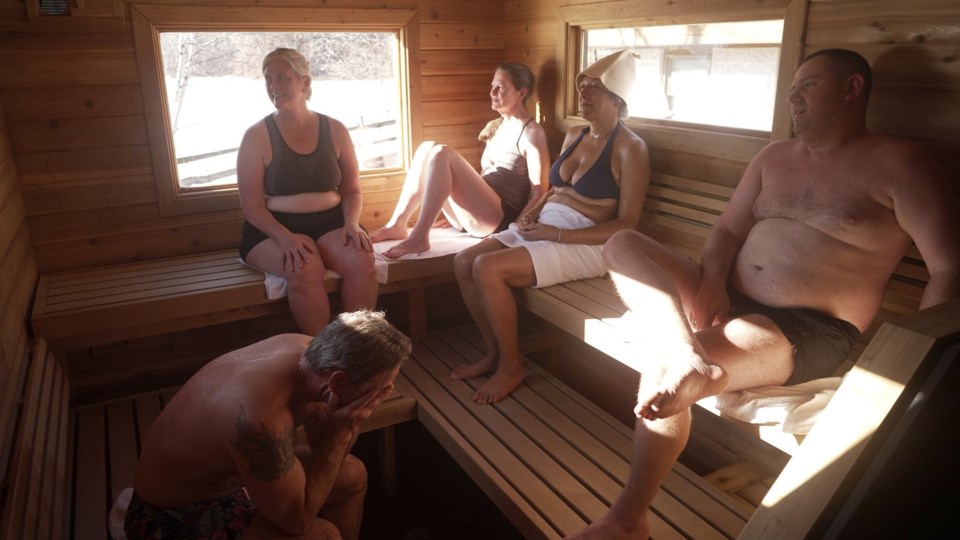EAGAN, Minn. (AP) — Ed Kranz set up his mobile sauna next to a frozen beach at Lebanon Hills Regional Park in Eagan, Minnesota, on a bone-chilling Sunday morning during a weekend cold snap.
Ed and his wife Colleen own Saunable, “a wood-fired sauna experience on wheels.” After about 8 to 12 minutes of sweating in the Kranz's 185 degrees Fahrenheit (85 degrees Celsius) sauna, a group moseyed outside into a 15 degrees Fahrenheit (9 degrees Celsius) Minnesota afternoon. They sat around a fire in bathing suits to gradually lower their body temperatures before repeating the process three or four more times. One brave soul submerged himself into a hole in the frozen lake for a post-sauna cold plunge.
The group was not alone. As temperatures drop into the teens, Minnesotans are embracing sauna culture for warmth and community. Devotees say the state's sauna mania is about more than sweat and snow — it is the product of Old World traditions intersecting with newfangled internet-based communities, and a desire for social connection in a society that can feel isolating.
How it works
Sauna and cold plunges go together like peanut butter and jelly, said Glenn Auerbach, a self-described sauna evangelist and the founder and editor of SaunaTimes. Auerbach started the website in 2008 to share his thoughts, research and conversations with an ever-expanding cadre of movers and shakers in the sauna world. He and his interlocutors mull over topics like the nitty-gritty of sauna construction, how to cultivate “good sauna vibes” and the potential health benefits of the sauna lifestyle.
A typical temperature to achieve the holy trinity of the sauna experience — heat, steam and ventilation — is about 180 to 200 degrees F (82-93 degrees C), a temperature that starkly contrasts Minnesota's frigid winter weather.
“Within our saunas, the stove should always win,” he said.
While sauna truisms such as this provide some degree of uniformity, there is also leeway for personal preference.
The craftiest of the lot in the sauna community can build a facility for about $10,000, according to Auerbach. Those looking to skip the physical labor can also outsource the construction. Sauna's popularity, which enthusiasts say spiked following , has brought with it a rise in manufacturers selling saunas for about $30,000 to $40,000.
While sauna's cultural cache may have increased in recent years, the practice long predates the Instagrammable spaces popping up in recent years, Auerbach said.
‘This is a tradition that’s actually for everyone'
The smell of cedar wood has been lodged in Justin Juntunen's memory ever since he first stepped into his family's sauna as a child. Juntunen, the founder of Cedar and Stone Nordic Sauna, is a descendant of Finnish immigrants who came to America in the 1880s. They and their compatriots brought with them an appreciation for saunas and the communal values the steam-filled rooms impart to local life.
People in Finland say there are more saunas than cars, Juntunen said. When immigrants like his grandfather came to Minnesota to work in the mines, mills or docks, they would often save up to build a farmhouse. But they would build a sauna first, living in the space while the main house was under construction. Later on, saunas would serve as informal town centers.
People gossiped in saunas, they gave birth in saunas and they died in saunas, Juntunen said. The public nature of the facilities reflects the egalitarian ethos that infuses Nordic culture, and sauna culture by extension, he added.
“This is a tradition that’s actually for everyone,” Juntunen said. “My favorite Nordic proverb is all people are created equal, but nowhere more so than in the sauna."
A practice that became an internet trend
In addition to a desire for in-person experiences following the isolation wrought by the COVID-19 pandemic, sauna enthusiasts say interest rose after some of the internet’s most famous figures, such as podcasters Joe Rogan and Andrew Huberman, touted it.
“Every big podcaster in the world discovered that you could jump in cold water and it feels kind of good. And then people click on it online,” Juntunen said.
In this way, technology has been a paradox for sauna culture, he added. Digital media helped sauna culture grow at the same time as saunas were billed as reprieves from the pervasive reach of technology over every facet of daily life.
‘Good heat is contagious’
Either way, almost all of sauna culture's adherents say its rise is inextricably linked to a desire for community.
Those who committed to building their own saunas have hosted friends, neighbors, and former high school hockey teammates over. This has created a new form of post-COVID-19 contagiousness: “Good heat is contagious,” Auerbach said.
This core function of sauna culture spans generations. Juntunen's grandfather would rush to the sauna after work because it was the space where stories were told.
"It’s a space where storytelling happens, where connection happens or silence happens," Juntunen said. “I think that is a really beautiful example of what a sauna truly is.”
Michael Goldberg And Mark Vancleave, The Associated Press




